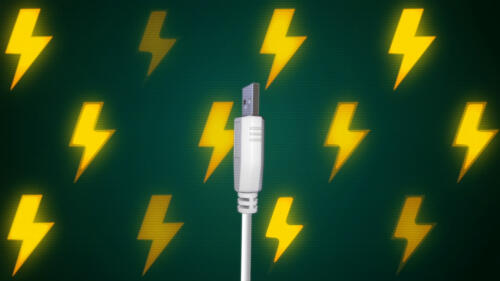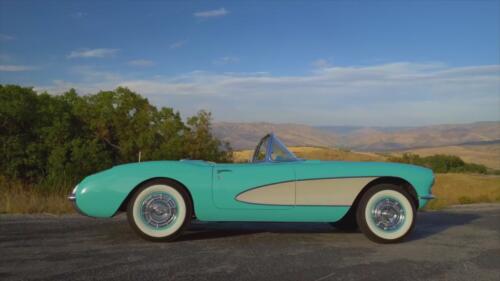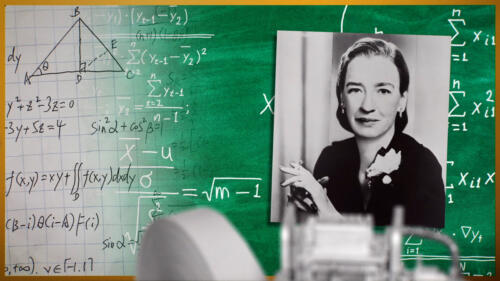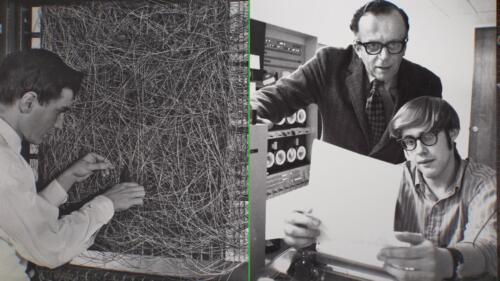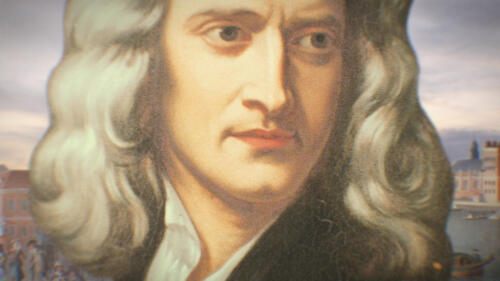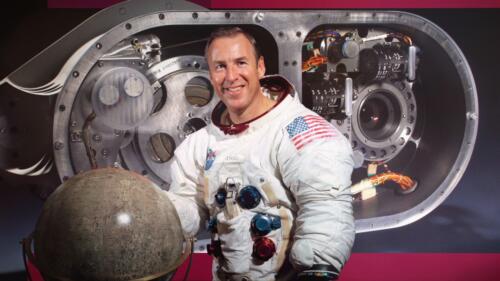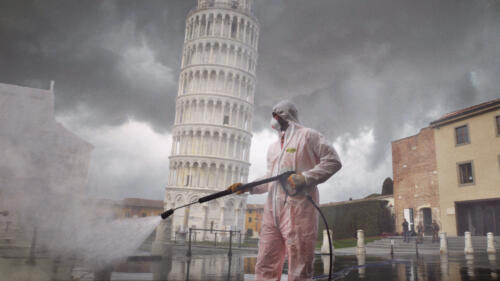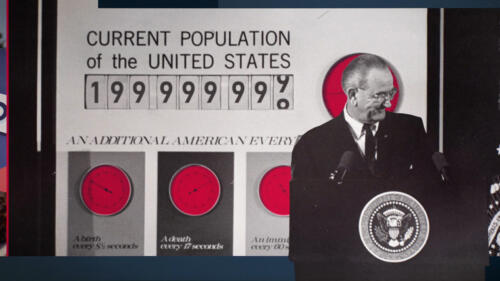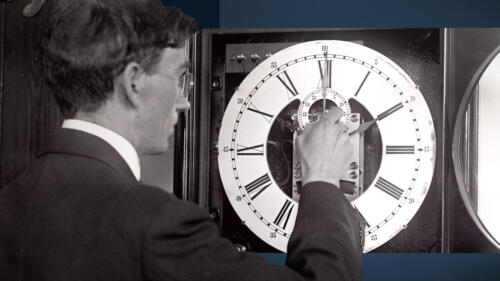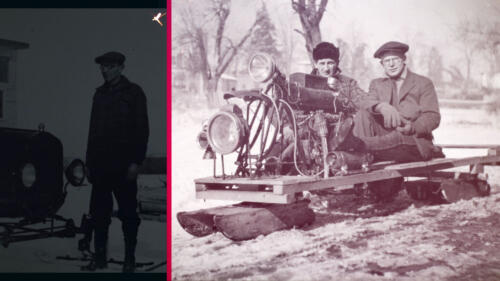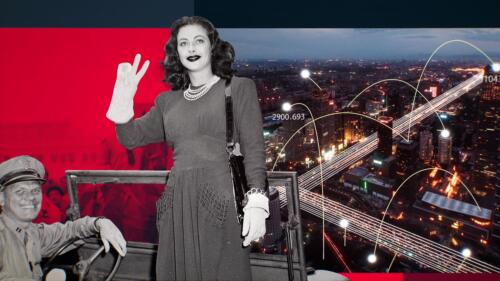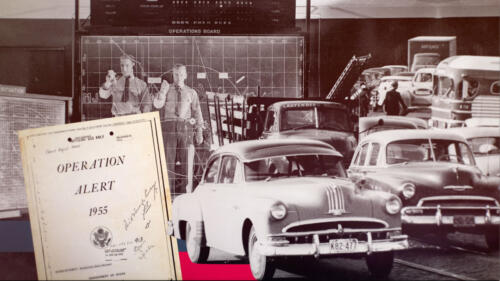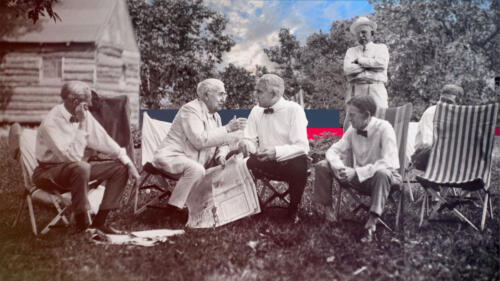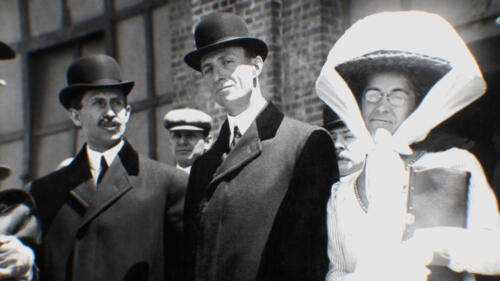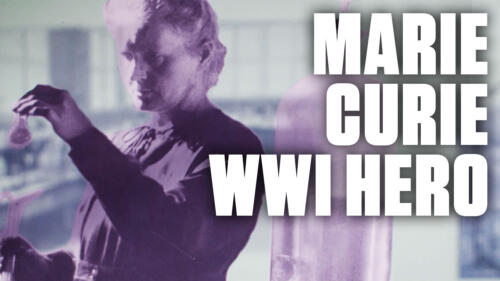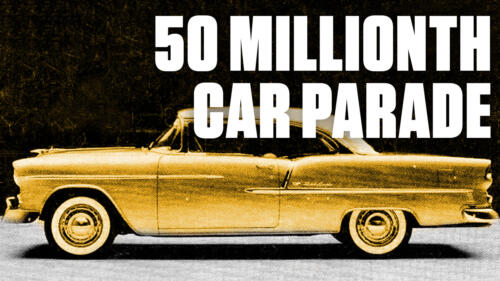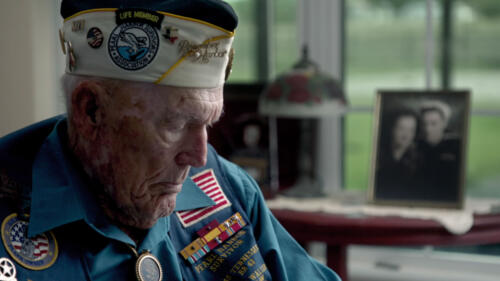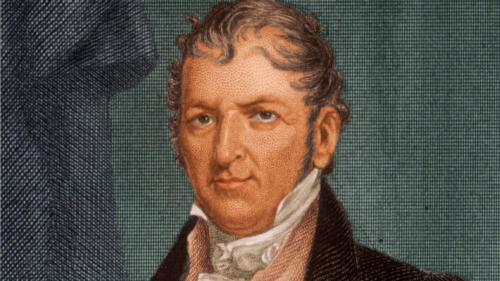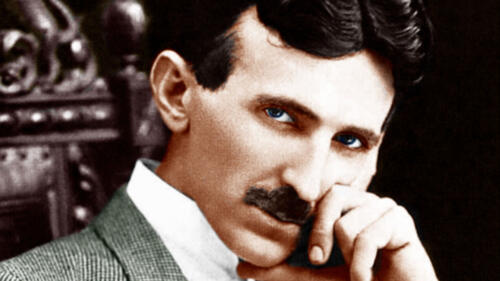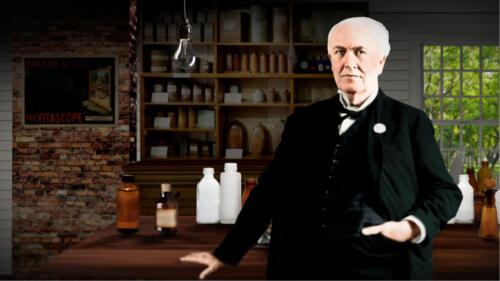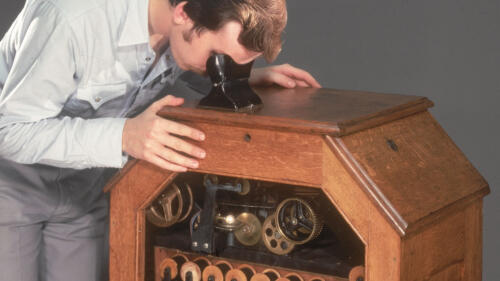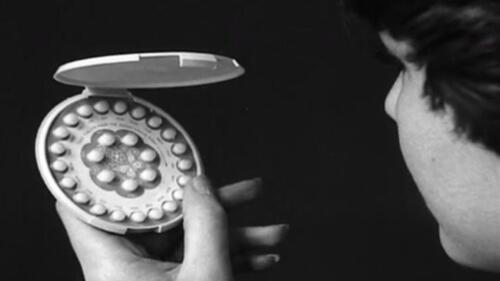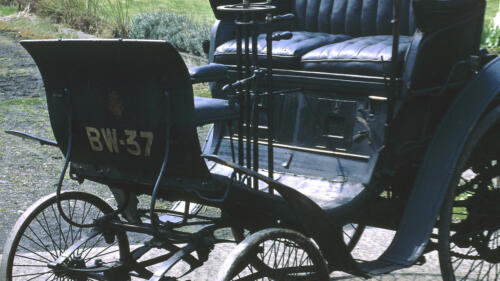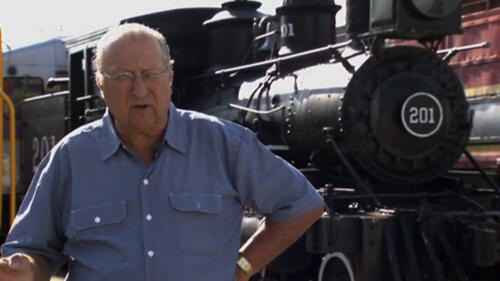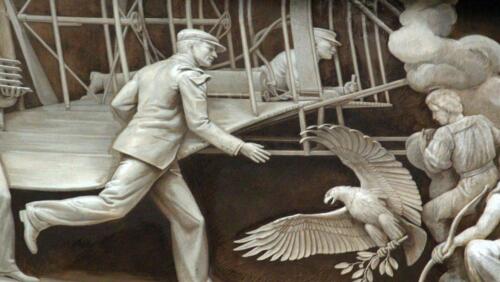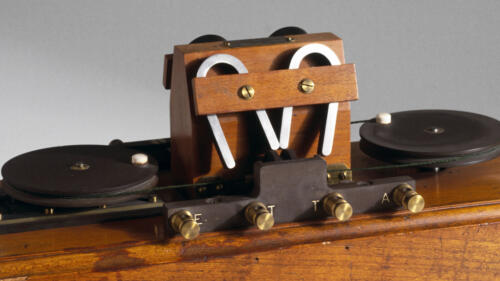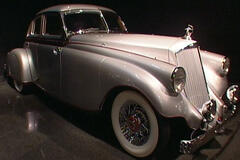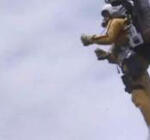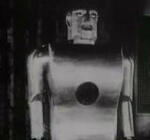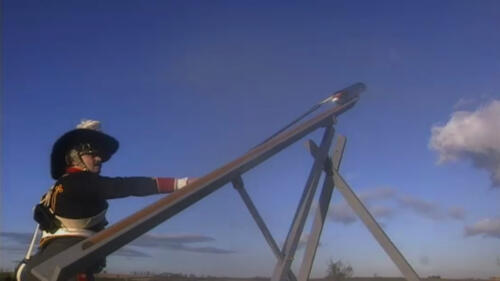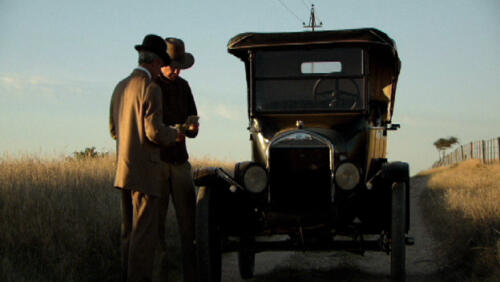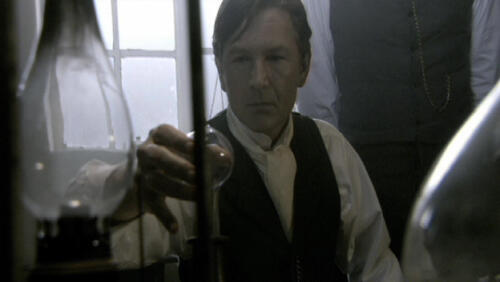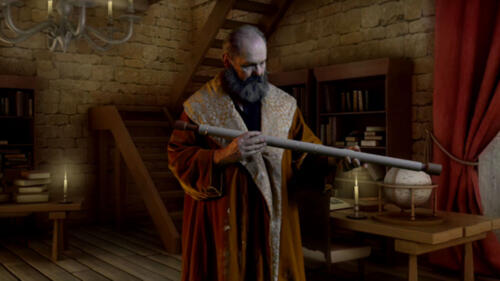Inventions & Science
Science and inventions have propelled human progress, as well as led to human destruction. From the creation of the first stone tools to reusable space rockets to the atomic bomb, each step builds upon the history of human knowledge.
Featured Overview
After much trial and error, Alexander Graham Bell finally invents the first telephone, which eventually replaces the telegraph - connecting the universe in more ways than one, in this clip from Season 1, "Telephone Wars."
8:42m watch

Illustration by Eduardo Ramón Trejo. Photos from Getty Images.
Featured Overview
After much trial and error, Alexander Graham Bell finally invents the first telephone, which eventually replaces the telegraph - connecting the universe in more ways than one, in this clip from Season 1, "Telephone Wars."
8:42m watch
Start Here

The epic race to standardize the electrical system—later known as the War of the Currents—lit up 19th-Century America.

Here are the milestones and innovations that drove the automotive revolution.

Some of the modern world's most groundbreaking technologies emerged during this 30-year period.

Barcode tech was first patented in 1949, but engineers came up with the UPC code in the 1970s to answer a need for better efficiency in grocery stores.
Top 10 Kitchen Inventions That Changed Food Forever
Top 10 Kitchen Inventions That Changed Food Forever
From fire to the air fryer, humans have a remarkable history of innovating in the kitchen. Discover the 10 kitchen inventions that changed food forever, in this episode of History Countdown.
10:48 watch

3 Important Inventions Discovered by Accident
Explore All Related Topics

From gold rushes to guerrilla wars, dynamite’s dual legacy is one of construction and destruction.

From thyroid hormones to amphetamine to the “fen-phen” craze, weight-loss drugs have emerged and continuously faced scrutiny, largely due to unintended health effects.

Here is the origin story of Earth—the only place we know life to exist.
The first USB flash drives hit the market in the late 1990s and were a game-changer. No more bulky floppy disks or slow CD-Rs—USB drives were small, portable and lightning-fast.
1:00m watch

Early versions of a carpet cleaning device were pulled by a horse, but it was a janitor who came up with a portable model you could plug in.
"Necessity is the mother of invention."
13:32m watch
Which of these toys were your favorite growing up?
12:42m watch

On March 14, 1951, Albert Einstein was celebrating his 72nd birthday at the Princeton Club in New Jersey when a group of photographers asked to take a photo.
Peyton Manning and guests take us through the greatest cars of all time.
13:41m watch
Grace Hopper, often called the mother of computer science, invented the first program that converted common-language commands into binary computer code, revolutionizing computer science and laying the groundwork for the programming languages we have today
1:00m watch

Many associate aspirin with willow bark, but the pills in your cabinet don’t come from a tree.
On October 29, 1969, Stanford programmer Bill Duvall sent a one-word message to student programmer Charley Kline who was 350 miles away at UCLA. This one-word message - "login" - was sent between two computers, each the size of large room. This message marked the first inter-computer communication, which many consider to be the birth of the internet.
The race to construct the first underwater telegraph intensifies after pressure to connect the U.S. to other countries increases.
7:32m watch

Avian influenza has been sickening birds at least since the 1800s—and has been a factor in the emergence of human pandemics.

Early in its existence, massive asteroids smashed into Earth with lasting consequences for our planet’s geology and life.

Despite its timeless appearance, the moon has not always been in Earth's orbit, and scientists continue to investigate its true age.

Engines ablaze. Tire blowouts at 300 mph. Sonic booms. The quest to break world land-speed records is not for the faint-hearted.

An 18th-century sign language in France helped inspire an American version that developed through collaboration among the Deaf community.

From a buck-toothed rodent to a shark that doesn't reach puberty until age 150, find out what creatures have the make-up for exceptional longevity.

Americans have been cashing in coupons since the 19th century. But the practice really took off during the Great Depression.

The benefits of fluoridated water was discovered in the early 1900s, when health officials in a Colorado city noticed residents had stained, but remarkably healthy teeth.

Barcode tech was first patented in 1949, but engineers came up with the UPC code in the 1970s to answer a need for better efficiency in grocery stores.

The carnage of World War I drove advances in new techniques and tools to collect and store blood and offer safe transfusions.

The first recorded hurricane forecast was issued by a Jesuit priest in 1875. A series of critical tools have since refined the science.

Eisenhower installed 'elevator music' in the White House and NASA used it in astronaut training, but its inventor came up with many other, more impactful inventions in his lifetime.

Seat belts came in simpler designs before safety concerns drove innovation, leading to the three-point version that is standard today.

Charles Richter worked with Beno Gutenberg to develop one of the first data-driven ways of comparing earthquakes.

While bras shape women’s bodies, the development of bras has been shaped by world events.

When a chemist discovered that carbon atoms could be used to date ancient remains, he devised a method that upended archaeology.

When news broke in 1997 that scientists had cloned a sheep, the world reacted in shocked amazement—and fear over the possibility of human cloning.

Josephine Garis Cochran had no formal mechanical engineering education, but she designed, built, marketed and sold her dishwashing machine back in the 1880s.

Elizabeth "Lizzie" Magie designed her original board game as a critique, not a tribute, to capitalism.

Early versions were developed as a convenience, but the device evolved to transform delivery in politics, news and entertainment.

Ancient Romans used versions made from linen, as well as animal intestines, to prevent the spread of infection.

At just age 15, Braille devised a revolutionary system using raised dots to expand reading options for blind students like himself.

The Internet got its start in the United States more than 50 years ago as a government weapon in the Cold War. Unlike technologies such as the light bulb or the telephone, the Internet has no single “inventor.” Instead, it has evolved over time.

From Technicolor to Animatronics to Droids in Training, Disney artists and engineers have continually broken new creative ground.
During the height of the Industrial Revolution, Josephine Cochran changed the game by inventing the first commercially successful automatic dishwasher, in this clip from Season 1, "Home Tech Revolution."
8:43m watch
After much trial and error, Alexander Graham Bell finally invents the first telephone, which eventually replaces the telegraph - connecting the universe in more ways than one, in this clip from Season 1, "Telephone Wars."
8:42m watch

These secret codes enabled secure communication—at least until others found ways to crack them.

Franklin's work paved the way for Watson and Crick's breakthrough discovery of the DNA double helix.

Albert Einstein's concept of general relativity is now a bedrock of physics, but it took years to confirm.

Lamarr was a glamorous movie star by day, but she was also a gifted, self-trained inventor who developed a technology to help sink Nazi U-boats.

From sleeping outside, to installing windows designed for airflow, find out how people tried to stay cool during heat waves before AC.

The dental hygiene tools available to our ancestors have evolved—but still bear a striking resemblance to what's used today.

Sometimes, the unexpected inspires new inventions.

In the late 1970s, smaller 'Star Wars' action figures took over.

From a magnet that can lift an aircraft carrier to a turbine blade longer than a football field, these brawny behemoths get the big jobs done.

Since the 1940s, the World Health Organization has worked with different countries to keep the flu endemic by identifying strains and watching for signs of a pandemic.

Some toys sprang from failed scientific experiments. Other were inspired by parents' jobs.

After much ado, the US and Britain laid the first successful cable under the ocean in August 1858. It stopped working weeks later.

A staggering 25,000 workers lost their lives. And artificial limb makers clamored for contracts with the canal builders.

These remarkable feats of design and construction transformed the ways people travel, communicate and live.

As interest in cultural, intellectual and scientific exploration flourished, support for an all-powerful church diminished.

Electric appliances large and small promised reduced drudgery.

The highly contagious disease dates to ancient times and spread easily in households and classrooms—until the development of a vaccine.

Multiple inventors deserve credit for the technology, which had its origins in the 19th century.
Many inventions that we use today were invented by the military - from zippers to Super Glue and even computers. Find out more in this episode of History Countdown.
11:14m watch

C.R. Patterson & Sons, which started as a carriage building firm, produced luxury roadsters and, later, bodies for service vehicles.

Here are the milestones and innovations that drove the automotive revolution.
Isolated in his family home from the Black Plague, Isaac Newton devised some of the most important scientific concepts of his time.
1:04m watch
Stranded in space, the Apollo 13 astronauts managed to find their way back home by using technology invented centuries earlier.
1:03m watch
Dr. Maurice Hilleman was already an expert in viruses and vaccines when a strange flu broke out in Hong Kong in 1957. But only he saw the threat it could pose around the world.
1:03m watch

It wasn't until the 20th century that inventors looked past single-use products.

The Italian astronomer argued that Earth and other planets revolve around the sun. Then he paid a price.

From wider, tree-lined boulevards to lush parks, some of the world’s most famous urban landscapes were shaped by 19th-century cholera pandemics.
The census has been around since the beginning of the United States, which meant the entire population had to be counted by hand. Until one inventor saw a better way forward.
1:00m watch
While Daylight Savings is fairly harmless today, it's origins lie in one of the most violent episodes of world history.
1:02m watch

While some of the earliest pandemics faded by wiping out parts of the population, medical and public health initiatives were able to halt the spread of other diseases.

It wasn't until the mid-19th century that doctors realized going straight from an autopsy to the maternity ward was not a good idea.

Edison's genius was improving on others' technologies and making them more practical for the general public.
Frustrated with the time spent cleaning his ice rink, Frank Zamboni did what any good inventor would do, and went to the drawing board.
1:03m watch
Snowmobiles are a common winter sight, but there was a time when driving in the snow took a bit more creativity.
1:02m watch

For millennia, six-legged soldiers have been conscripted to torment enemies.

Early researchers used horse hairs and burning machines to try to quantify people’s physical suffering.
We love marshmallows in hot chocolate and s'mores, but before they were a campfire treat, these fluffy pillows were used as medicine!
1:01m watch
Hedy Lamarr, Hollywood actress, is known for more than her acting—she invented a signal-hopping technology used in Wi-Fi.
1:00m watch
Nuclear bombs played a key role in the planning and building of the Interstate Highway System.
1:01m watch
Love it or hate it, the beer can is an iconic part of American culture. But there was a time when the beer can was almost made extinct.
1:02m watch
The invention of charcoal briquets came about thanks to a glamping trip by Thomas Edison and Henry Ford.
1:02m watch
The ice cream cone is one of America’s favorite treats, but it was actually a happy accident that gave us this beloved dessert.
1:02m watch

Patients—including presidents, business titans and movie stars—flocked to his Battle Creek Sanitarium, where treatments included 15-quart enemas and electrical currents to the eyeballs.

These aircraft, tanks, rocket launchers and more serve as the workhorses of American warfare. One has even earned the nickname "the finger of God."

John Alcock and Arthur Whitten Brown flew across the Atlantic with the help of a sextant, whisky and coffee in 1919—eight years before Charles Lindbergh's flight.

From the Batmobile to Mr. Bean's Minis...from KITT to General Lee...here are some of the coolest, most memorable small-screen car stars.

Behind the mysterious gap year of America's quintessential sports car.
American history author David McCullough explores the near fatal accident Wilbur Wright had while testing an airplane.
1:02m watch

As the Great Depression raged, scientists Pearl Kendrick and Grace Eldering developed the first effective pertussis vaccine on a shoestring budget.

Einstein's theory of relativity paved the way for black holes' discovery, but the concept behind their existence was so bizarre that even the scientific visionary was not convinced.

Autopilot has existed since 1912. But some experts worry that too much plane automation introduces danger.

Scientists had to overcome problems with the vaccine’s safety, then public health officials had to take on complacency about the disease.

Blame it on “Snowball Earth.”
Marie Curie, Nobel prize winner, also invented mobile radiology units and saved numerous lives in World War I.
1:29m watch
Coffee is one of America's favorite drinks, even going back to the country's earliest days. As shown in this caffeinated tribute, the 1960s were no exception.
2:39m watch

The soybean originated in China, but its history in the U.S. has ranged from an experimental crop to a Civil War coffee substitute, to a leading U.S. export.

The origin story of the first iPhone reveals that Jobs was just trying to make a really cool phone.

In the late 19th century, thousands of premature babies' lives were saved—while attracting oglers at amusement parks.
In 1908, the Wright Brothers began testing what would become the first U.S. Army airplane. Many people who witnessed these tests had never seen a man take flight. Within ten years, entire battles would be fought in the sky.
1:32m watch

For just shy of 50 years, General Motors had been making some of the most popular cars in the country. In 1954, they celebrated their 50 Millionth automobile in style.
On November 23, 1954, General Motors celebrated their 50 millionth car by throwing a massive parade in Flint, Michigan – the home of Chevrolet's Motor Division. The celebration featured bands, dancers, floats, and the 50 millionth car itself, a gold-plated Chevrolet Bel Air Sport Coupe.
2:49m watch
Engineers once believed flying at the speed of sound would be impossible, but on October 14, 1947 U.S. Air Force pilot Chuck Yeager’s sonic boom changed history.
4:21m watch

For the first few years, they originally sold for less than a buck.

These thrill seekers liked to make things go zoom-zoom—and risked their lives in the process.
The Goat? The 'Cuda? The Boss Nine? It's a question that sparks fierce debate.

The famed physicist would later denounce racism, but his diaries reveal shocking reflections from when he was a young man.

Sonic weapons have been used for literally thousands of years to disrupt, confuse and even injure opponents.

The printing press, which allows for the mass production of printed matter, originated in China before Johannes Gutenberg perfected his version around 1450.

The FBI has finally declassified its files on Nikola Tesla, but questions remain.

The ‘little blue pill’ helped the world talk about sex. But 20 years after its FDA approval, what has it really done for relationships? Esther Perel weighs in.

The retailer turned everyone into a “Toys ‘R’ Us kid”… by driving its competition out of existence.

The American Revolution was fought—and won—with guns, and the weapons have become ingrained in U.S. culture, but the invention of firearms started long before colonists ever settled on North American soil. The origin of firearms began with gunpowder and...

The flu, or influenza, is a highly contagious viral infection that mainly affects the respiratory system. It’s usually a seasonal illness, with yearly outbreaks killing hundreds of thousands of people around the world. Though rare, completely new versions of the virus may infect people and spread quickly, resulting in pandemics (an infection that spreads throughout the world) with death tolls in the millions.

These are the playthings that caused sellouts and stampedes.

Is this what the Zodiac Killer would have sounded like?

Originally a second banana character in 'Donkey Kong' in 1981, Mario went on to conquer the video game world.

PTSD Symptoms Post-traumatic stress disorder is a mental health condition that occurs when someone witnesses or experiences a severely traumatic event. This can include war or combat, serious accidents, natural disasters, terrorism, or violent personal ...

If it wasn’t for a series of fires, the iconic toy may never have been built.

What Is Cholera? Cholera is an infectious disease caused by a bacterium called Vibrio cholerae. The bacteria typically live in waters that are somewhat salty and warm, such as estuaries and waters along coastal areas. People contract V. cholerae after d...

Though video games are found today in homes worldwide, they actually got their start in the research labs of scientists early 1950s. Academics designed simple games, like tic-tac-toe and tennis for two, as part of their research or for fun on the side.

Bumper-to-bumper roadblocks that left drivers stranded for days.

The first chess algorithm didn’t even run on a computer.

People didn’t always need birth certificates.

Which were the most influential cars in U.S. automotive history? Here are our picks:

For over a century, roller coasters and other amusement park rides have provided thrills by walking the line between scary and fun.

The two-wheeler evolved—and seriously improved—over the course of a century, thanks to several different inventors.

Albert Einstein may have been a genius, but when it came to relationships, he was just as clueless as the rest of us—maybe even more so. In a letter written near the end of his life to the family of his closest friend, Michele Besso, the great physicist shared poignant regrets about his two marriages […]

These futuristic visions have yet to come to fruition, either because of technological limitations or market viability—or both.

While the advent of train travel altered previously held concepts of time and distance, learn about 10 railways and train journeys that also changed the course of history.

Author of 'The Immortal Life of Henrietta Lacks' discusses the extraordinary ways medical research benefitted from an African American woman's cells—without her consent.

A new book investigates the truth behind famous quotations that have been wrongly attributed, misremembered, garbled in translation—or are flat-out fake.

Explore the history of this iconic weapon.

The date has been an official annual celebration of the mathematical sign since 2009.

10 surprising facts about the widely acknowledged inventor of the telephone.

You've heard of the Wright Brothers—but what about Alberto Santos-Dumont or Gustave Whitehead?

From ancient Greek elections to a famously corrupt contest from 19th century Louisiana, get the facts on eight of history’s most notable lotteries.

Casey Jones was a locomotive engineer who became a folk hero after his death in a train crash in 1900 was commemorated in a number of songs. According to legend, Jones died with one hand on the train’s whistle and the other hand on its brake. Born John Luther Jones in Missouri in 1863, the […]
Survivors describe the invisible wounds sustained after Pearl Harbor, and the measures they took to heal them.
1:56m watch

It may be hard to believe, but not too long ago major American cities banned pinball out of fear of the arcade game’s effect on crime, juvenile delinquency and morality.

For much of the late 18th and early 19th centuries, a chess-playing automaton known as the “Turk” drew huge crowds at exhibitions across Europe and the United States.

Archaeological evidence suggests that the ancient Romans may have driven their carts and chariots on the left, and the practice seems to have carried over into parts of medieval Europe. The reasons for this are not entirely certain, but some believe it arose as a matter of safety. The majority of people are right handed, […]

On August 6, 1991, without fanfare, British computer scientist Tim Berners-Lee published the first-ever website while working at CERN, the huge particle physics lab in Switzerland.

Explore the celebrated roadway, which was made obsolete by high-speed interstates and decommissioned by the federal government in 1985—although much of it remains drivable today.

In 1886, German inventor Karl Benz patented what is generally regarded as the first modern car. Less than two decades later, in 1903, Massachusetts and Missouri became the first states to require a driver’s license, although it wasn’t necessary to pass a test to obtain one. In 1908, Henry Ford launched the Model T, the […]

Explore the surprising history behind the evolution of the nickel.

From an early glider experimenter to the first man to fly solo around the world, here are six lesser-known pilots and inventors who made their mark on aviation.

From an oar-powered prototype to the original U.S. Navy submarine, here are nine undersea vehicles that were among the first in history to take the plunge.

Check out 10 surprising facts about the pioneering woman often cited as the world’s first computer programmer.
Eli Whitney's idea for interchangeable parts led to the second wave of industrialization across the United States. Find out more about his life (and his cotton gin) in this video.
3:36m watch

Many of modern society’s most cherished institutions and ideas—not to mention the objects we use every day—can trace their origins back to the ancient world.

Legend has it that a young Isaac Newton was sitting under an apple tree when he was bonked on the head by a falling piece of fruit, a 17th-century “aha moment” that prompted him to suddenly come up with his law of gravity. In reality, things didn’t go down quite like that. Newton, the son […]

Einstein’s groundbreaking scientific ideas made his name a synonym for genius, but he was also famous for his pacifist views and support of the civil rights movement. Explore nine surprising facts about one of the towering minds of the 20th century.

Get the facts on the iconic Italian astronomer and physicist.

From the Middle Ages to the late 17th-century, the so-called “philosopher’s stone” was the most sought-after goal in the world of alchemy, the medieval ancestor of chemistry. According to legend, the philosopher’s stone was a substance that could turn ordinary metals such as iron, tin, lead, zinc, nickel or copper into precious metals like gold […]

Find out more about this fascinating Englishman, from the job he held that involved sending people to the gallows to the cause of one of his most bitter rivalries.

The pernicious disease may have been infecting humans for 12,000 years.

In celebration of National Pretzel Day (April 26), explore the history of this popular snack food, from the seventh century to today.

Coca-Cola’s disastrous attempt at rebranding Coke in 1985 delivered a painful lesson: Don't mess with a classic.

From an ancient optical apparatus to the advent of color film, learn the stories behind eight of the most important steps in the development of photography

One of history’s most famous infectious disease carriers, she was put into forced isolation for more than two decades.
![Sir Isaac NewtonENGLAND - JANUARY 01: Sir Isaac Newton (1642-1727) .Canvas. (Photo by Imagno/Getty Images) [Sir Isaac Newton (1642-1727) . Gemaelde.]](https://res.cloudinary.com/aenetworks/image/upload/c_fill,ar_1.7777777777777777,w_640,h_360,g_auto/dpr_auto/f_auto/q_auto:eco/v1/isaac-newton-gettyimages-56458980?_a=BAVAZGDX0)
Sir Isaac Newton (1643-1927) was an English mathematician and physicist who developed influential theories on light, calculus and celestial mechanics. Years of research culminated with the 1687 publication of “Principia,” his landmark work that established the universal laws of motion and gravity.

The epic race to standardize the electrical system—later known as the War of the Currents—lit up 19th-Century America.

Bread may be one of the world’s oldest prepared foods. But pre-slicing was a 20th-century innovation.

When Thomas Edison demonstrated the first practical incandescent light bulb on New Year’s Eve 1879, it marked the dawn of the electric age.

From a July 2 Independence Day to a doomed Civil War general’s last words, get the facts on seven predictions that were famously off the mark.

In ancient times, many scientists believed the speed of light was infinite and could travel any distance instantaneously. The Italian physicist Galileo Galilee was among the first to try to measure the speed of light. In the early 17th century, he devised an experiment in which two people with covered lanterns stood a known distance […]
Before his death, Nikola Tesla was reportedly working on what the press called a "Death Ray." It was a weapon so powerful it could obliterate military targets from hundreds of miles away, but did it actually exist?
1:35m watch

Check out 10 surprising facts about the father of modern psychoanalysis.

Check out some fascinating facts about the Serbian-American physicist and engineer.

In the 18th century, the French government hosted a competition to find a better means of food preservation. The winning invention changed how the world ate.

This week we’ll take a look at the surprisingly long history of mobile dining.

The first writing system is believed to have developed during the second millennium B.C.

On the 200th anniversary of Samuel Colt’s birth, learn 10 surprising facts about the gun manufacturer and industrialist.

An 18th-century English nobleman helped popularize the snack—so much so that it eventually took on his name.

If you’re a scientist, a student or a citizen of any country in the world except for the United States, Myanmar or Liberia, there’s no avoiding the metric system. The system, featuring meters, liters and kilograms, was adopted following the French Revolution and devised by a group of French scientists in an effort to create […]

The barber pole’s colors are a legacy of a (thankfully) long-gone era when people went to barbers not just for a haircut or shave but also for bloodletting and other medical procedures. During the Middle Ages bloodletting, which involves cutting open a vein and allowing blood to drain, was a common treatment for a wide […]

The beloved chocolate candies have been to war and space and back again—and for more than 10 years the red ones went missing in action.

Ancient mariners used to gauge how fast their ship was moving by throwing a piece of wood or other floatable object over the vessel’s bow then counting the amount of time that elapsed before its stern passed the object. This method was known as a Dutchman’s log. By the late 16th century, sailors had begun […]

Commonly seen on doctor’s prescription pads and signs in pharmacies, Rx is the symbol for a medical prescription. According to most sources, Rx is derived from the Latin word “recipe,” meaning “take.” Among several alternative theories, however, is the belief that the Rx symbol evolved from the Eye of Horus, an ancient Egyptian symbol associated […]

Although elevators may seem like a modern invention, devices used to transport people or goods vertically have been around for thousands of years. According to the writings of Vitruvius, the Greek mathematician Archimedes created a primitive elevator in 236 B.C. that was operated by hoisting ropes wound around a drum and rotated by manpower applied […]

Explore six lasting legacies of the 1964 New York World’s Fair on the 50th anniversary of its opening.

From Italian ravioli, to Polish piroshky, to Chinese pot stickers, the humble dumpling is beloved by eaters around the world.

Doctors are supposed to operate under the maxim “do no harm,” but history shows this has sometimes been easier said than done.

Researchers have confirmed that a tiny gem found in western Australia is the oldest known piece of Earth, dating back some 4.4 billion years.

Originally consumed as a bitter drink, it was prized as both an aphrodisiac and an energy booster.

10 surprising facts about the famed evolutionary biologist Charles Darwin.

According to new research by a Canadian historian, the 1918 flu outbreak that killed 50 million people originated in China.

A history of nothingness.

Get the story behind the annual event and find out how to make a batch of your own.

As you might expect for a technology so expansive and ever-changing, it is impossible to credit the invention of the internet to a single person. The internet was the work of dozens of pioneering scientists, programmers and engineers who each developed new features and technologies that eventually merged to become the “information superhighway” we know […]

Check out 10 things you may not know about the aviation pioneers.

Americans eat about a million pounds of the stuff a year.
Get the full story behind the aches, pains and dangerous history of the flu.
2:47m watch

The mastermind behind this summer indulgence wasn’t a marketing honcho, or even a chef—it was an 11-year-old boy.
What would happen if the world's oil supply suddenly dried up? Fordham University Professor Christiana Peppard imagines what a world without oil would be like.
4:03m watch
Thomas Edison wasn’t the only inventor to lay claim to the light bulb, so whose bright idea was it? Ask History finds out.
1:57m watch

From their humble beginnings as cooking utensils to paper-wrapped bamboo sets at the sushi counter, there’s more to chopsticks than meets the eye.

Explore some of history’s most famous sibling pairs.

Not just tasty but essential for life, salt has a long and tumultuous history all its own.

A tragic event in Morse's life started him on his path towards inventing the telegraph.

According to estimates, more than 7 billion people live on our planet. Each day, some 200,000 new babies add to this figure, which works out to roughly 140 additional people per minute. Over an entire year, about 80 million humans are born—a number comparable to the combined populations of California, Texas and New York. Not […]

From pioneering inventions to bold scientific and medical advancements, find out more about 11 innovations that changed the course of human history.

From the earliest steam locomotives to today’s high-speed 'bullet trains,' here are eight things you may not know about the 'iron horse.'

It’s hard to credit a single person with inventing the automobile. Not only did an estimated 100,000 patents lead to cars as we know them, but people also disagree on what qualifies as the first true automobile. For historians who think that early steam-powered road vehicles fit the bill, the answer is Nicolas-Joseph Cugnot, a […]

If you're wondering where the dollar sign ($) came from, you're in good company.

Find out about some of the weird and wacky ways people have attempted to curb or conceal their hair loss over the centuries.

Looking for an innovative dental hygiene enthusiast to thank next time you polish your pearly whites? Turns out it’s not that simple. People have been cleaning their teeth for millennia, starting with the ancient Egyptians, who are thought to have scrubbed their choppers with a special powder made from ox hooves and eggshells as far […]

Did you know pizza took the United States by storm before it became popular in its native Italy?

Discover six things you may not know about the Medal of Honor and its recipients.

Since its debut in 1947, the clock's minute hand has indicated the potential for global destruction—or world peace.
Thomas Edison had over 400 patents in just 8-years, but not all his ideas took off. See some bizarre failures from the Wizard of Menlo Park.
4:09m watch
Shots of a test nuclear explosion in Hawaii. | Courtesy of the Department of Energy Nevada Operations Office
1:26m watch
History Uncut The History Channel: 1987 - A young Gates, donned with oversized glasses that refuse to stay in place, answers questions from the press about his dazzling new software Microsoft Excel, which "really improves the quality of your output." This video clip is courtesy of The History Channel.
1:27m watch
Ancient civilizations used advanced engineering techniques to access water for both health and luxury.
4:12m watch
A look at some common, and not so common contraceptives.
3:05m watch
History takes a closer look at one of the greatest minds the world has ever seen. Find out what you have always wanted to know about Albert Einstein.
3:19m watch
Who inspired Henry Ford to get into the car business? See why motorized wheels have been called one of the greatest inventions in modern history.
3:35m watch
Albert Einstein began his career as a patent clerk in Switzerland and was known for being a daydreamer.
2:22m watch
The ambitious Albert Einstein challenges centuries of scientific thought with his new controversial idea, the General Theory of Relativity.
2:55m watch
Some things you might not know about this vital transportation system and role it plays in supporting the backbone of American industry.
4:19m watch
In a Mail Call video, R. Lee Ermey answers a question from Rusty of Laurel Hill, Florida, who wants to know what the first helicopter used in combat was. Ermey explains that Russian emigrant Igor Sikorsky was the inventor of this helicopter, called the R-4. The year of 1943 was when Sikorskys R-4 became the worlds first helicopter to go into mass production; it was also the first helicopter in U.S. Military service and the first to operate from a ships deck. After a few modifications, the helicopter became the YR-4B and on April 25th, 1944 it became the first helicopter to ever fly in combat. Pilot LT. Carter Harmon used the YB-R4 to rescue 4 men who had crash landed in extremely rough terrain.
1:19m watch
Inspired by a childhood toy, Orville and Wilbur go on to design and fly the world's first powered airplane.
2:55m watch
History takes a closer look at one of the greatest minds the world has ever seen. Find out what you have always wanted to know about Albert Einstein.
2:24m watch
Alexander Graham Bell thought he was on to something, but no one wanted his new invention. Hear the first verbal messages to travel by wire and through the air.
3:49m watch
The awe-inspiring Hoover Dam was built in the 1930s from enough concrete to create a two-lane highway from Los Angeles to Boston. How long did America's largest, man-made reservoir take to complete?
4:23m watch
In 1922, Albert Einstein finally proves his General Theory of Relativity and that same year wins the Nobel Prize, but surprisingly not for his famous theory.
2:23m watch
Take a look at some of the most luxurious cars ever manufactured, including the Cadillac v16, the Mercedes Gullwing and the Lamborghini Countach.
7:12m watch
The first radio signals beamed across America In the early 20th century. See how this cultural revolution began.
1:53m watch
History takes a closer look at one of the greatest minds the world has ever seen. Find out what you have always wanted to know about Albert Einstein.
2:03m watch
Although a popular concept since the 1960s, this flying invention never quite got off the ground. Find out why.
1:26m watch
Nuclear submarines are priceless military jewels, owned and operated by only a handful of countries. Find out what it takes to operate one of these prized vessels.
3:07m watch
The Dymaxion House, invented by Buckminster Fuller, lead to the geodesic dome concept. See how it rocked the world of architecture.
3:41m watch
In this video clip of History's Mail Call, host R. Lee Ermey takes a look at what kind of rockets were the first used in combat. In 1807 William Congreve created the Congreve Rocket which was used in the Napoleonic Wars. It weighed 32 pounds and could fire 2,000 yards in about 29 seconds.
3:16m watch
Albert Einstein published four important scientific papers in 1905, referred to as his Miracle Year.
3:00m watch
Thomas Edison gave us the light bulb, but it wasn't easy. See how multiple failures lead to a revolution that helped light up the world.
3:12m watch
Find out how Henry Ford's Model T revolutionized transportation in America.
3:18m watch
Thomas Edison's most famous invention, the lightbulb, paved the way for modern life.
2:51m watch
Find out why Galileo's beliefs in a heliocentric solar system threatened the Catholic Church and caused him to stand trial for heresy.
3:33m watch

Eating meat may have allowed our ancestors to grow fruitful, multiply and spread across the planet, a new study suggests.

Explore surprising facts about the one-cent coin.

As news breaks of the longest organ transplant chain to date, explore the history of these potentially lifesaving procedures.

Marie Curie won not just one Nobel Prize in her lifetime, but two, for her groundbreaking work in radioactivity.

Last week, Charles Darwin became the latest “patient” at an annual conference that aims to unravel the medical mysteries of long-dead historical figures.

Invention of the PC: The Computer Age The earliest electronic computers were not “personal” in any way: They were enormous and hugely expensive, and they required a team of engineers and other specialists to keep them running. One of the first and most ...

New research suggests that a layer of molten rock or magma may lie some 1,800 miles beneath our feet, sandwiched in between the Earth's core and its lower mantle.

Galileo’s Early Life, Education and Experiments Galileo Galilei was born in Pisa in 1564, the first of six children of Vincenzo Galilei, a musician and scholar. In 1581 he entered the University of Pisa at age 16 to study medicine, but was soon sidetrac...

The Model T, sold by the Ford Motor Company from 1908 to 1927, was the earliest effort to make a car that most people could actually buy. It became so popular at one point that a majority of Americans owned one, directly helping rural Americans become more connected with the rest of the country and leading to the numbered highway system.

Development of Ether Before its development as a surgical anesthetic, ether was used throughout the history of medicine, including as a treatment for ailments such as scurvy or pulmonary inflammation. A pleasant-smelling, colorless and highly flammable ...

Preindustrial Gunmaking Gunmaking was considered an extremely skilled craft in the 18th century, and firearms, including pistols and muskets, were all constructed by hand. In this way, every gun was a one-of-a-kind possession, and a gun broken could not...

When Were Cars Invented? The 1901 Mercedes, designed by Wilhelm Maybach for Daimler Motoren Gesellschaft, deserves credit for being the first modern motorcar in all essentials. Its thirty-five-horsepower engine weighed only fourteen pounds per horsepowe...

“A Motor Car for the Great Multitude” Before Henry Ford introduced the Model T on October 1, 1908, horseless carriages–otherwise known as automobiles–were a luxury item, available only to an elite few. For this reason, many people viewed the autos and t...

The Early Days of Automated Banking Many experts believe that the first automated banking machine was the creation of an American inventor and businessman named Luther Simjian. Simjian held patents on all kinds of things–including an army flight simulat...

In 1862, the Central Pacific and the Union Pacific Railroad Companies began building a transcontinental railroad that would link the United States from east to west. Over the next seven years, the two companies raced toward each other from Sacramento, California on the one side to Omaha, Nebraska on the other, struggling against great risks before they met at Promontory, Utah, on May 10, 1869.

Whitney Learns About Cotton Eli Whitney was born on December 8, 1765, in Westborough, Massachusetts. Growing up, Whitney, whose father was a farmer, proved to be a talented mechanic and inventor. Among the objects he designed and built as a youth were a...

Guglielmo Marconi’s Early Years Guglielmo Marconi was born in 1874 in Bologna, Italy. His father was a wealthy landowner and his mother was a member of Ireland’s Jameson family of distillers. Marconi was educated by tutors and at the Livorno Technical I...

Alexander Graham Bell is known for his many inventions, especially the telephone and a metal detector. He later created the Bell Telephone Company, now AT&T.

Thomas Edison was a prolific inventor and businessman whose inventions include the phonograph, incandescent light bulb, motion picture camera and alkaline battery.

The telegraph and Morse code revolutionized long-distance communication after their invention in the 1800s by Samuel Morse and other inventors.

Early Years Samuel Colt was born on July 19, 1814, in Hartford, Connecticut, the son of textile manufacturer Christopher Colt and wife Sarah. By visiting his father’s mill in Ware, Massachusetts, and helping out at a nearby farm, the young Colt gained a...

Serbian-American engineer and physicist Nikola Tesla made dozens of breakthroughs in the production, transmission and application of electric power.

Nicolaus Copernicus was a Polish astronomer who developed a heliocentric theory of the solar system, upending the belief that Earth was the center of the universe.

Henry Ford established the Ford Motor Company in 1903, and five years later the company rolled out the first Model T. Ford introduced revolutionary new mass-production methods, including large production plants, the use of standardized, interchangeable parts and the world’s first moving assembly line for cars.

The Wright brothers, Wilbur and Orville Wright, were U.S. inventors and aviation pioneers who achieved one of the first flights with a powered airplane.

Is it true that Einstein helped invent the atomic bomb? No. In 1939, when he learned that scientists in Berlin had figured out how to split a uranium atom, Einstein wrote a letter to President Franklin Roosevelt urging him to do whatever it took to make...

Einstein’s Early Life (1879-1904) Born on March 14, 1879, in the southern German city of Ulm, Albert Einstein grew up in a middle-class Jewish family in Munich. As a child, Einstein became fascinated by music (he played the violin), mathematics and scie...




